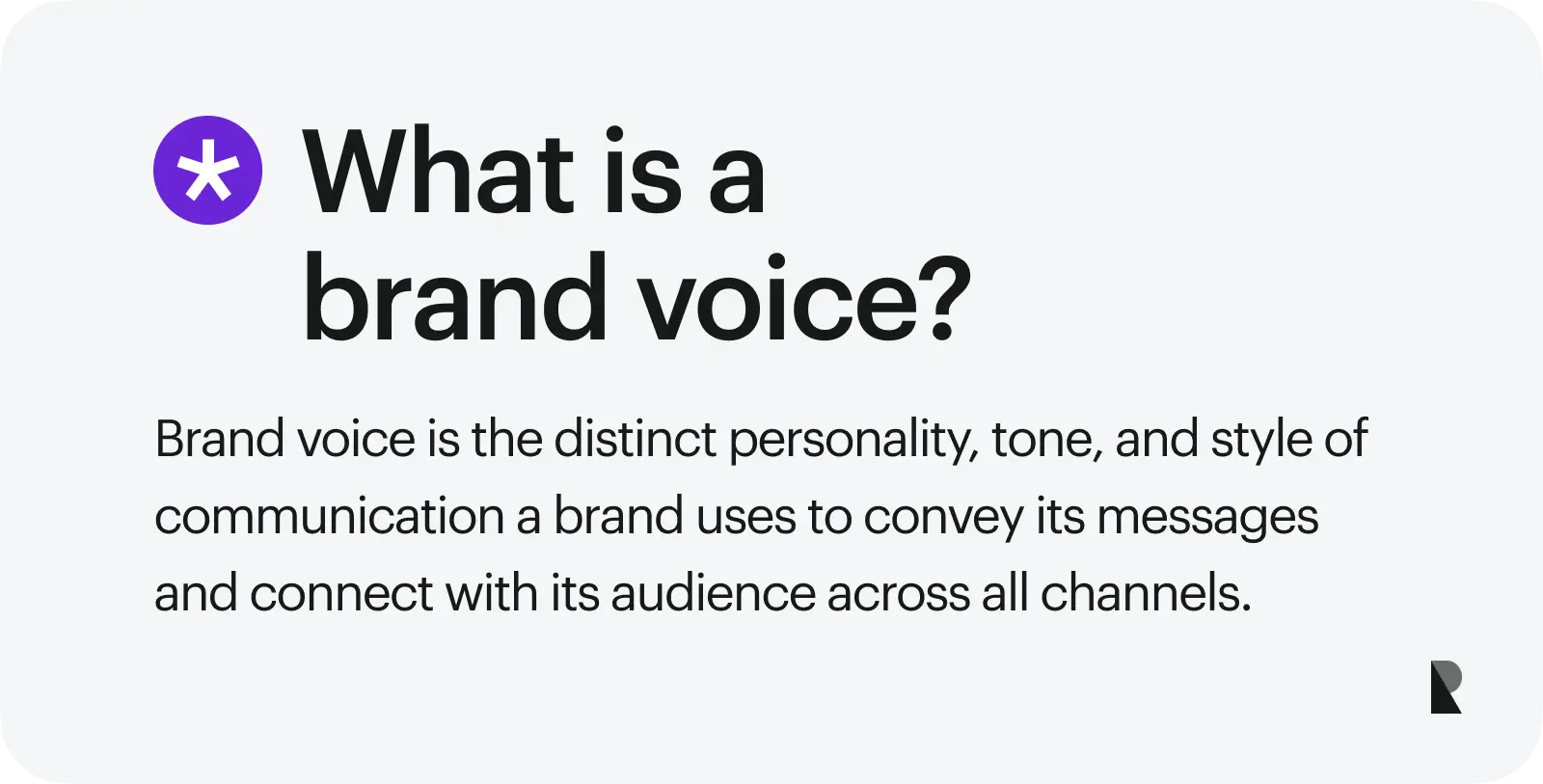
Do you know that there are 500,000 brands in the World spread across more than 2000 product categories? Impressive. While this makes customers' lives much more manageable by filling missing gaps and meeting current needs and requirements, it certainly creates obstacles for companies to stay afloat.
Even though this staggering number is constantly changing since companies and products come and go, the competition in every niche is getting tougher and tougher each year because the attention span of clients is getting lower, and the market is becoming oversaturated. As a result, most startups fail during the first five years.
How can companies survive? As many professional agencies that provide brand services agree, startups should prioritize brand recognition and find their unique brand voice that will get to customers' hearts.
What is a brand voice?
It is a distinct brand personality preached by the company across all distribution channels, including all sorts of communications and connections established with customers. It is crucial to note that it can be absent in some marketing materials, but it should always be present in all messages destined for clients.
The significance of identifying your unique brand voice is that it impacts the entire view of a brand. It helps the audience understand your brand values, distinct personality, and ideology as you create dialogue and ipso facto establish a foundation for relationships. Let's dive deeper into this concept to understand the basics and techniques to build it for your company.
Understanding Brand Voice
Before diving into the essentials of a brand's voice, it is crucial to answering why brand consistency is important because one of the significant impacts of the right voice on the company is amplifying coherence and regularity of brand perception through communication channels.
The benefits of ensuring brand consistency are significant. For instance, it leads to brand recognition. The better brand consistency, the stronger brand recognition will be. It also reinforces the company's qualities, solidifies the brand's reputation, and increases conversions.
Brand voice matters and should be prioritized by companies right from the start. Just consider what it can do.
- It reflects the brand's personality.
- It makes communication, especially social media posts, authentic.
- It separates the company from the competition.
- It appeals to the customers and ties emotions to the products company sells.
- It increases the familiarity of the brand.
- It produces the proper gamut of emotions.
- It builds brand loyalty.
Last but not least, a distinct brand voice helps affect the bottom line and may even increase revenue by 30%, according to recent studies.
Brand Tone and Voice – What is the Difference?
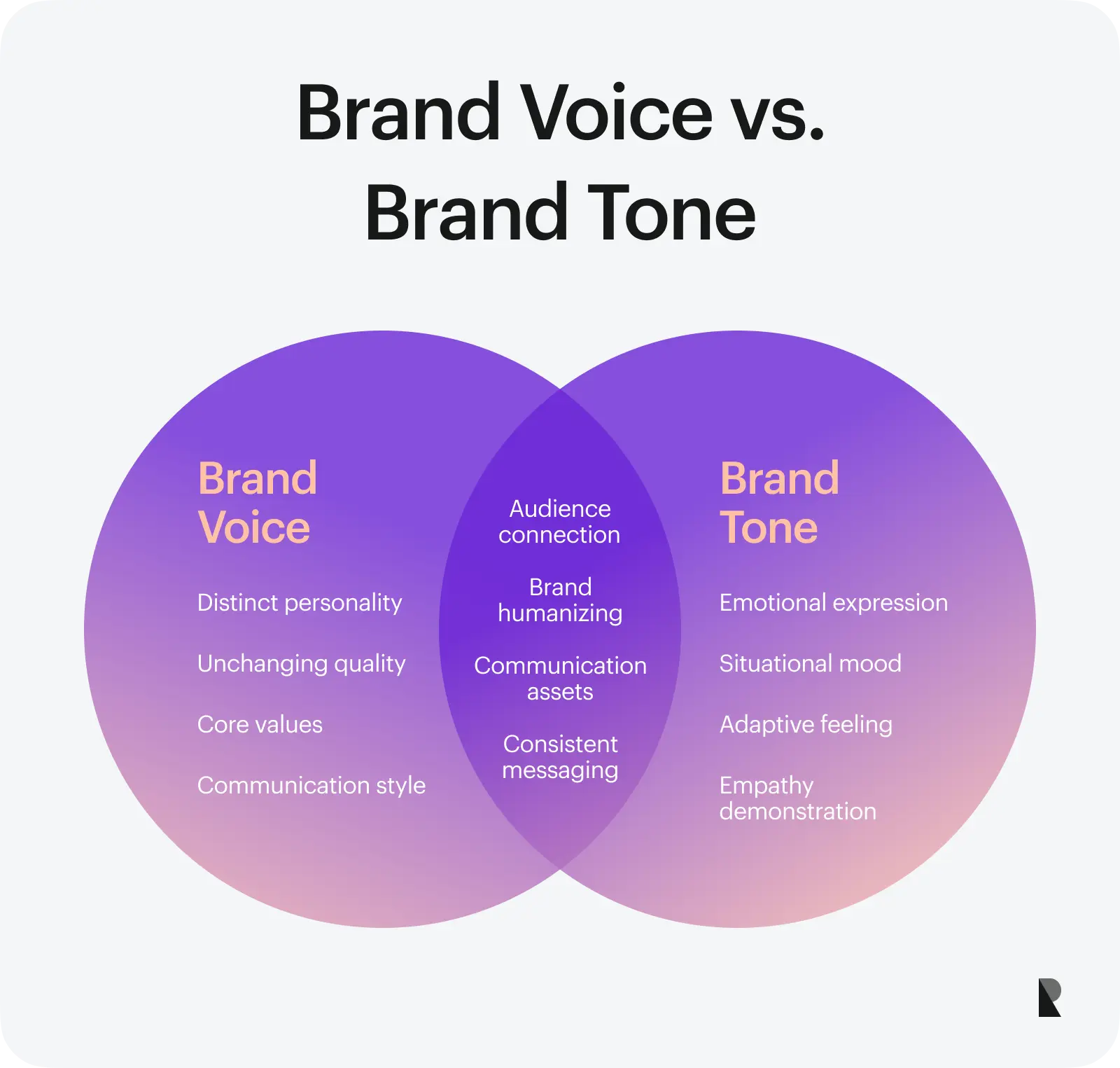
Brand tone and voice are interconnected concepts. Although some use them interchangeably, they are not the same. Understanding the difference between these two is crucial to make the most out of them. So, what is what?
Brand voice reflects the unique company's qualities and values, making it recognizable in a world full of different information streams. It is a company's distinct personality delivered to the user's door through all available means of communication. As a rule, it does not change.
Brand's tone is the emotional part of the company's communication with clients. It demonstrates the mood company has in messages to your audience using specific words and writing style. It is how you express your own brand voice in different situations.
These two core elements are interconnected, but still, they are different. Note brand tone changes depending on the situation because it reflects the feelings of your company and demonstrates empathy to your clients.
Your own brand's voice and tone are assets used to "speak" to the audience. In the cold digital World filled with digital assistants, these two are more critical than ever. They establish a warm connection with clients, humanizing the brand and making it closer and more trustworthy.
How to Uncover Brand Voice?
Before developing strong features of your brand voice and deciding what tone it will have in different situations, it is crucial to find it. Believe it or not, many companies fail to do this simply because they skip this step. As a result, they end up with a random assortment of voices and different tones in the content distributed through marketing and social media channels.
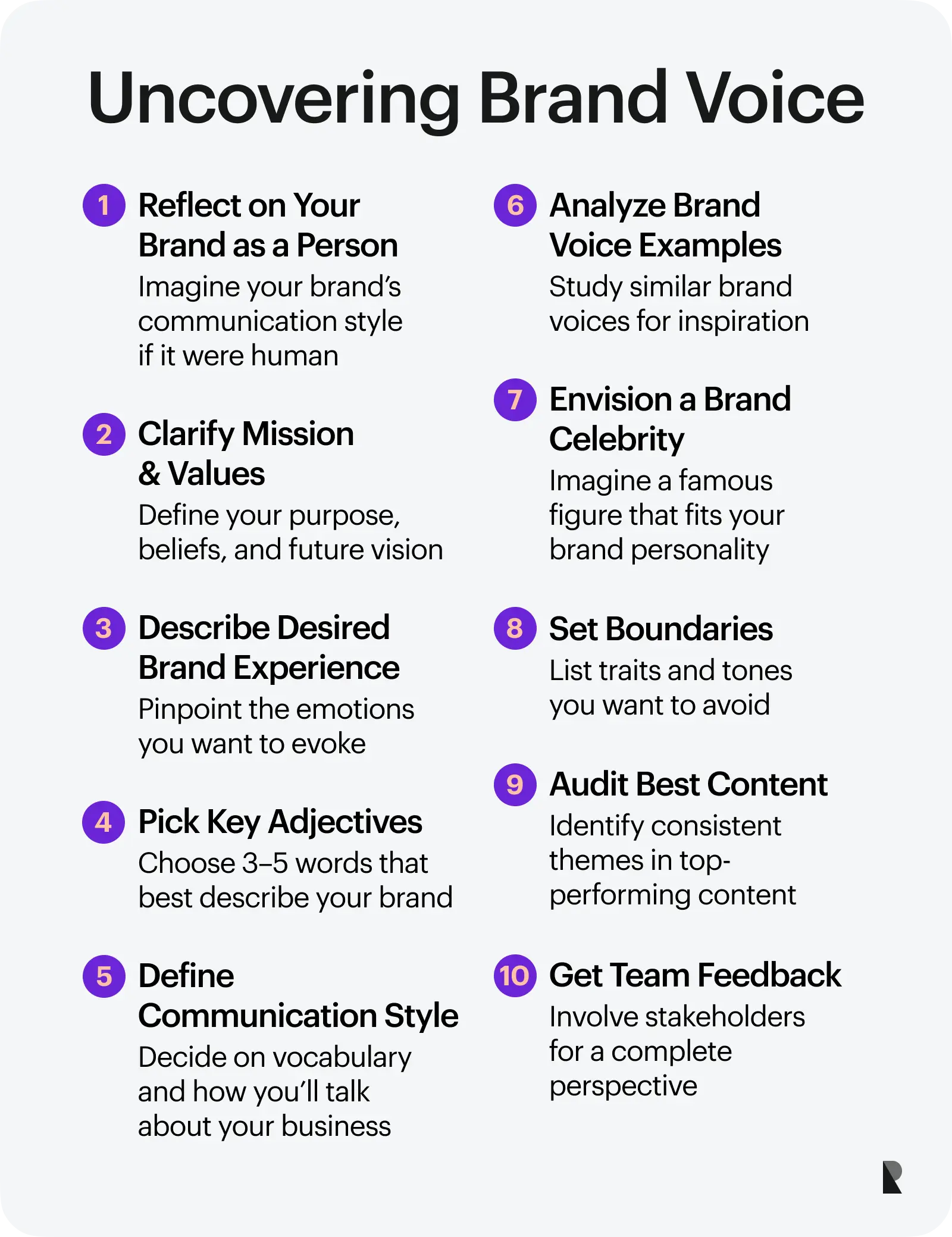
So, how to avoid this? Start with uncovering your brand. Remember, finding your unique voice calls for reflection of who you are, understanding that, and staying true to yourself. Check out these simple yet effective exercises to find your distinct brand voice.
Exercise one: Take the time to think about the larger picture of your company. Ask yourself, what if it was a human? How should it communicate with clients, friends, and colleagues?
Exercise two: Articulate your brand's core beliefs and company's mission statement. Describe the brand's purpose, mission, values, and future. Ask yourself what your company should stand for in the future. How your company's personality can help to do this?
Exercise three: Identify and try to describe in words the emotional brand experience you are trying to deliver.
Exercise four: Choose from 3 to 5 adjectives that describe your company.
Exercise five: Describe how you want to talk about yourself and your business. What type of vocabulary do you use?
Exercise six: Examine examples of brand voices with the same tone. How do they resonate with you? What can you learn from that?
Exercise seven: Imagine your brand is a celebrity. Who can it be? What features does it have?
Exercise eight: Ask yourself who you do not want to be. Describe features, behavior, words, and specific tone you want to avoid.
Exercise nine: Look at your best-performing content. Even if you have not defined brand voice, you already have a brand glossary. Analyze it – it can become a good base.
After doing all these exercises, get a collective opinion about that. Ask your co-founder, team, and stakeholders. Gather feedback about your brand and what brand voice it should be. Use a brand voice template for that.
8 Steps for Developing a Compelling Brand Voice
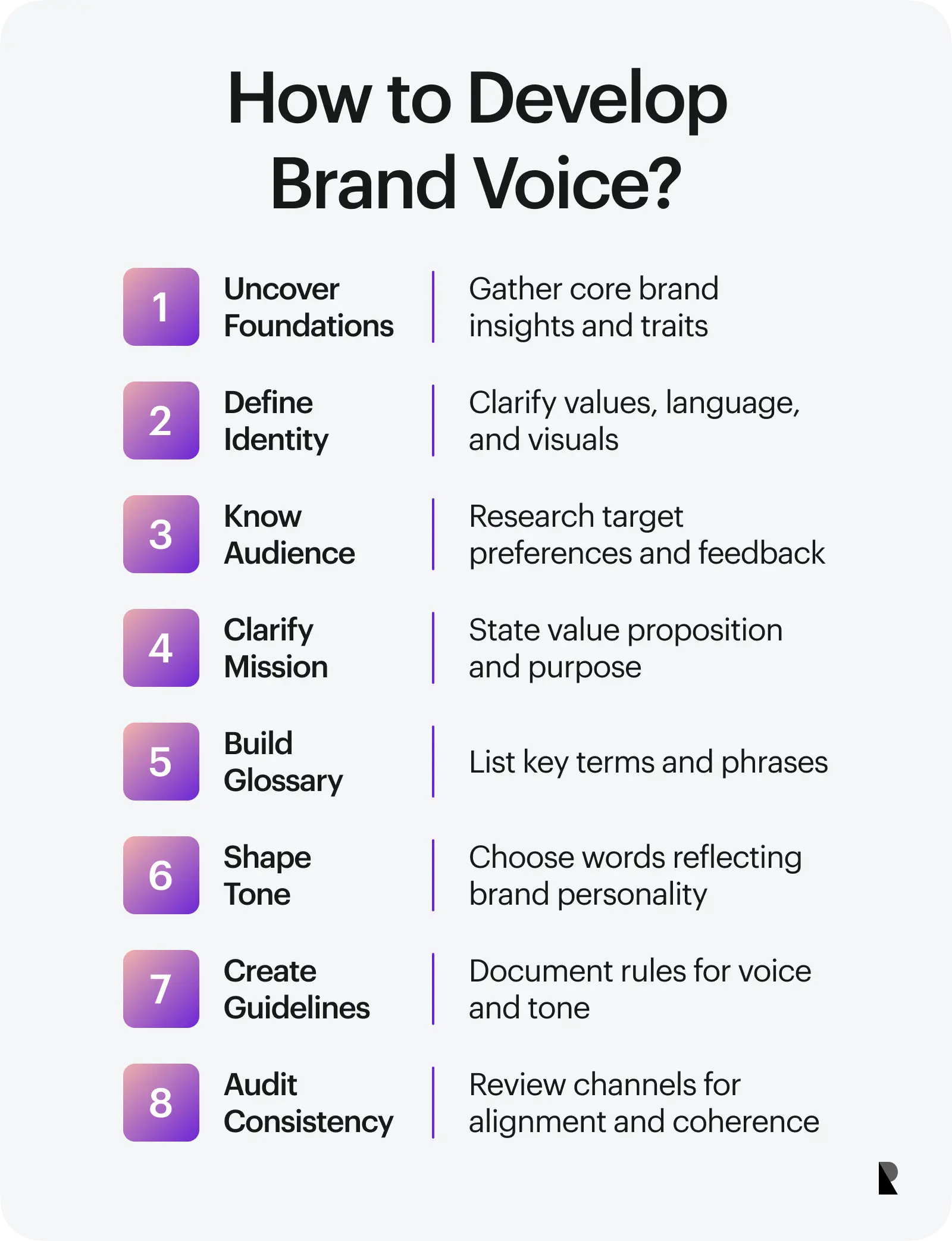
The process of crafting a powerful brand voice begins with uncovering it.
Step 1
We have already mentioned some good exercises that allow companies to do that. Pay attention to them; information received from that step will create a solid foundation to build brand voice and tone and achieve consistency and coherence through communication channels.
Step 2
After clarifying who you are and what brand voice you want, it is time to do some homework. Believe it or not, first and foremost, you must cover the essentials of brand identity and strategy. The reason for that is simple. Values, language, and visual elements contribute to a brand voice and help to develop it. Therefore, it is crucial to determine them beforehand.
Step 3
The next step is to define the target audience, its preferences, and expectations. Use marketing tools – they fine-tune brand voice and tone. Gather feedback from your customers or collect data using online questionnaires.
Step 4
Clarify the brand mission. Explain your brand's unique value proposition and remind everyone who you serve.
Step 5
Create a company glossary. It should include the terms and turns of phrases used in your content to refer to products or services, address problems and opportunities, and refer to people, including colleagues and customers.
Step 6
Build out brand tone. Using core brand traits, write down words that reflect your personality traits. Find phrases that showcase that to help the brand voice to live up to your expectations. Check out four primary tone-of-voice dimensions described by Nielsen Norman Group.
Step 7
Create brand voice guideline. Since it should encompass everything said and done before, it requires undivided attention. It should be a North Star for your team. They need to refer to it in times of need, confusion, and despair. It should also bring your company back on track. As a rule, the specs include the following:
- Company glossary and vocabulary.
- Level of formality.
- Length and structure.
- Grammar and spelling rules.
- Brand personality and tone.
It is also highly recommended to include words and writing samples that should be used by the customer's support team.
This guide should underline all decisions made in blog posts, emails, social media posts, marketing materials, and sales pages. Create a brand voice template for that.
Step 8
Audit your marketing platforms to ensure your successful brand voice stays consistent and aligned with the specs and brand identity.
Professional Tips for Creating a Strong Brand Voice
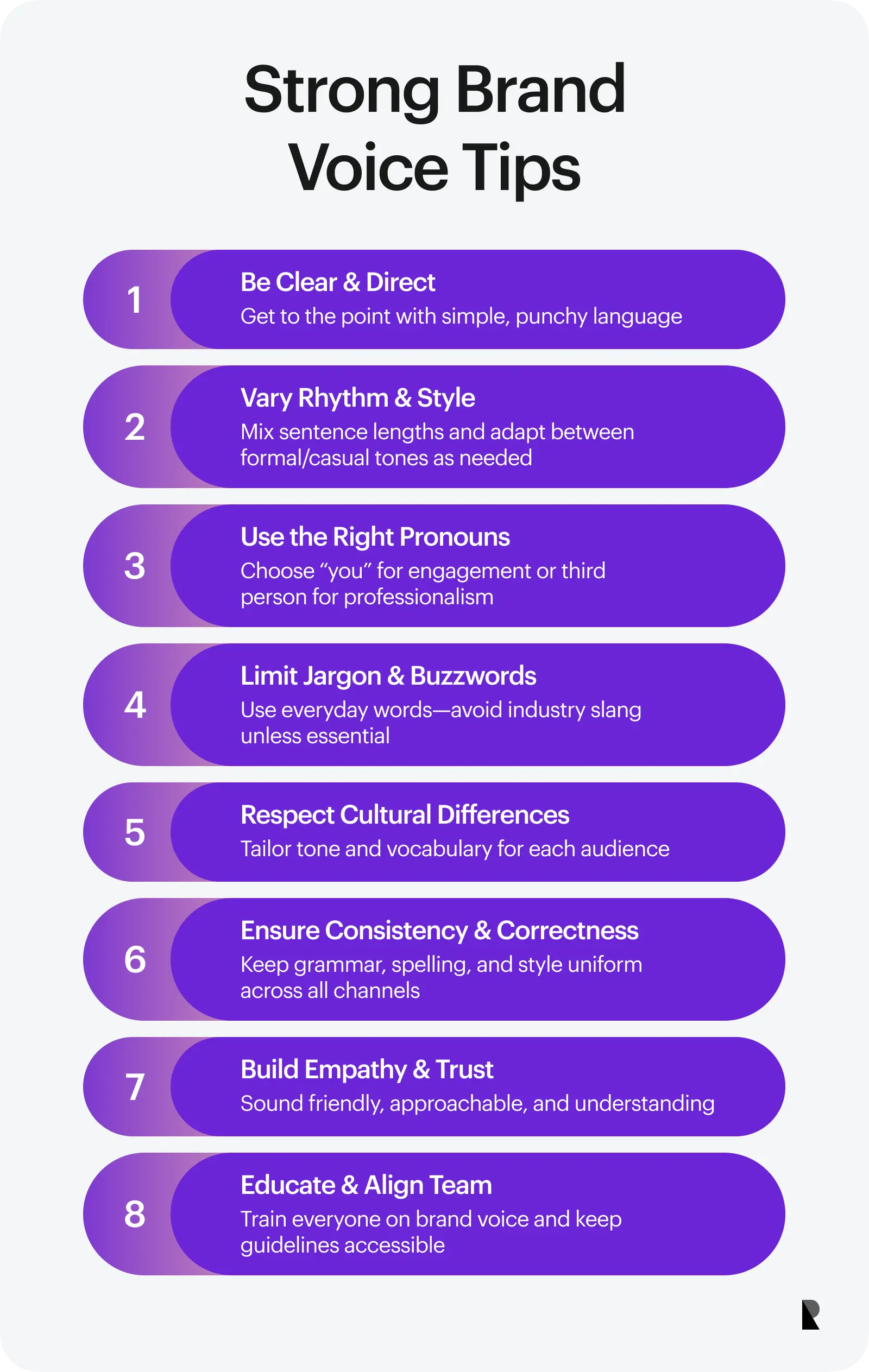
Developing a strong brand voice is a challenge that takes lots of time to tackle. You must pay thorough attention to your audience's reaction and monitor all communication channels, including hundreds of social media posts, to spot inconsistencies and catch a drift of changes.
It is crucial to do your best to face this challenge successfully. This includes adopting the best practices shared by professionals in the niche. Check out our list of tips – it is a good starting point.
- Create an organic and varied rhythm in messages.
- Get to the point right away.
- Understand five basic types of linguistic registers: frozen, formal, consultative, casual, and intimate.
- Use shorter words because they are easily understandable. However, note that short words are punchier and more brutal, whereas long words are softer and more relaxing.
- Choose the way of referencing clients wisely. For instance, if you use the second person, you may sound direct and engaging, whereas using the third person makes you more distanced but serious.
- Be careful with jargon and buzzwords.
- Use contractions to sound more informal, relaxed, and accessible. Use colloquialisms to sound more friendly or adopt the tone of an expert chatting to a non-expert.
- Understand specific locational and cultural differences.
- Fix misspellings, and grammatical errors.
- Use empathy to create a connection, but stay friendly to build trust.
- Refrain from frustration by sounding professional or neutral.
- Create an interconnected ecosystem for user experience. Ensure agents from any point in the buyer journey share the same data.
- Create a unique company language to make your customers feel like a part of the community.
- Make a do's and don'ts list and create a brand voice chart.
- Educate your team and ensure everyone is on the same page.
Brand Voice Examples
We have numerous brands we trust and recognize everywhere in the World. They provide us with some great brand voice examples.
1. Starbucks
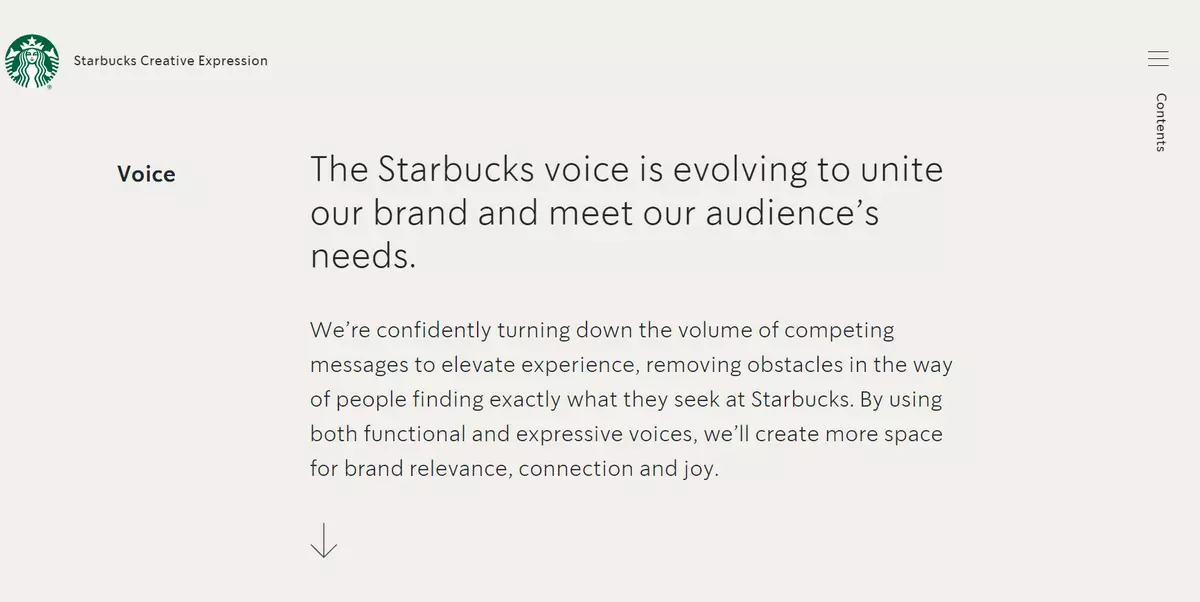
(Image taken from the official website)
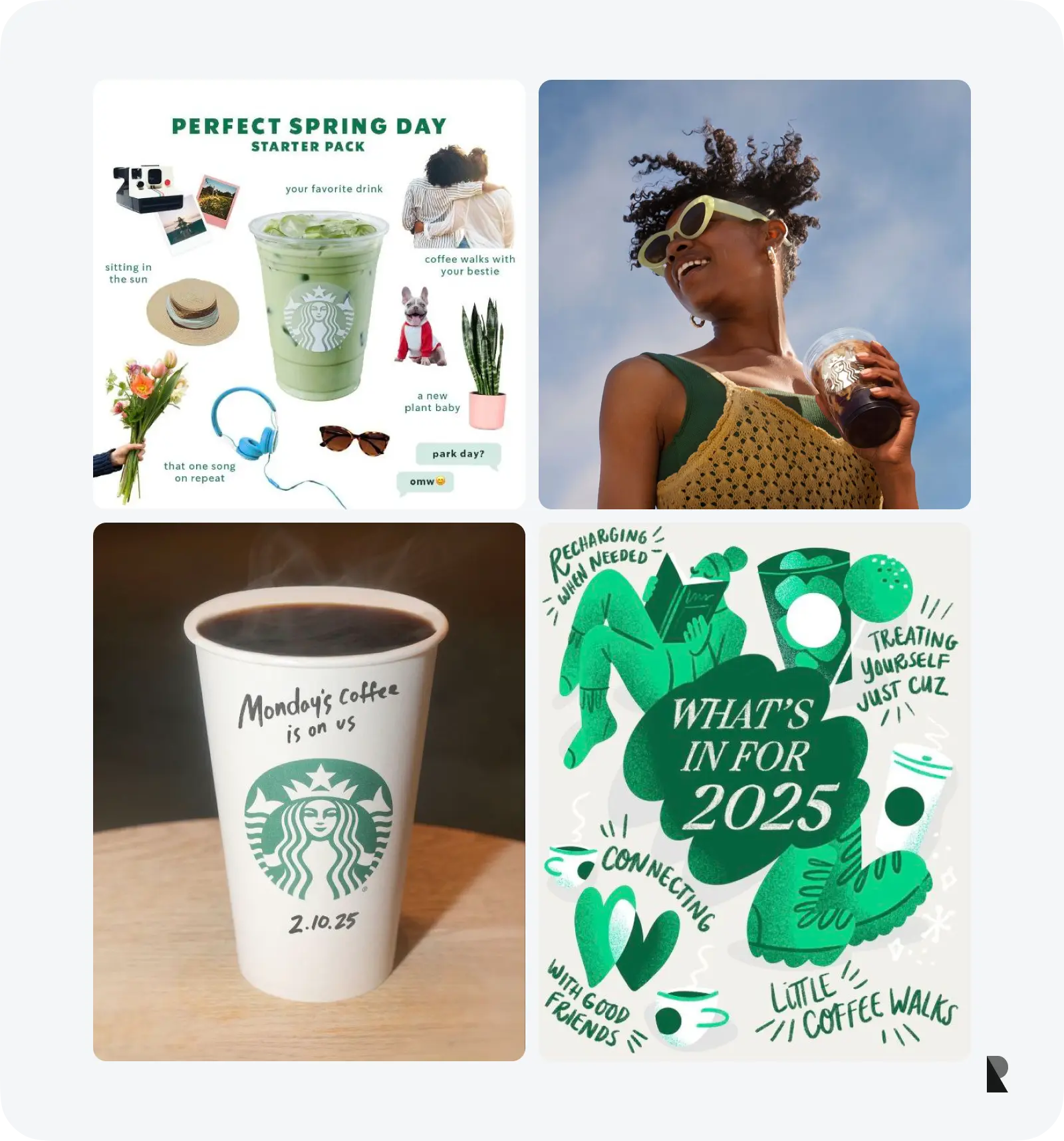
Starbucks is the first in our collection of brand voice examples. This is one of the most famous multinational chains of coffeehouses in the World. What's their secret? Besides regular clever advertising campaigns in Hollywood movies, it has a well-thought-out brand voice.
Their style guide covers everything from in-store graphics to website design to Instagram posts. They stick to functional and expressive voices across all communication channels to support and cultivate the brand's relevance, connection, and joy.
It is crucial to note that Starbucks has invented its own vocabulary. Just recall their cup sizes and names of holiday drinks. They have created a unique storytelling experience. This tweak has a massive impact because only customers of Starbucks know how to decipher this terminology. This makes them feel like a part of a community and something special.
2. Apple
We could not help but include Apple in our collection because this company excels in branding and marketing. Note how their brand stands for innovation, sophistication, and perfection without much pressure. The deal is their brand voice and tone are correctly done.
Apple always sounds confident and professional, strengthening its perception and reputation. Their copy at all their digital communication channels gets straight to the point focusing on perfection and the benefits customers will get. As for their slogans and taglines, they are always sleek and clever.
Note how their brand voice can be seen in brick-and-mortar stores and advertising. Consistency is a key to their success.

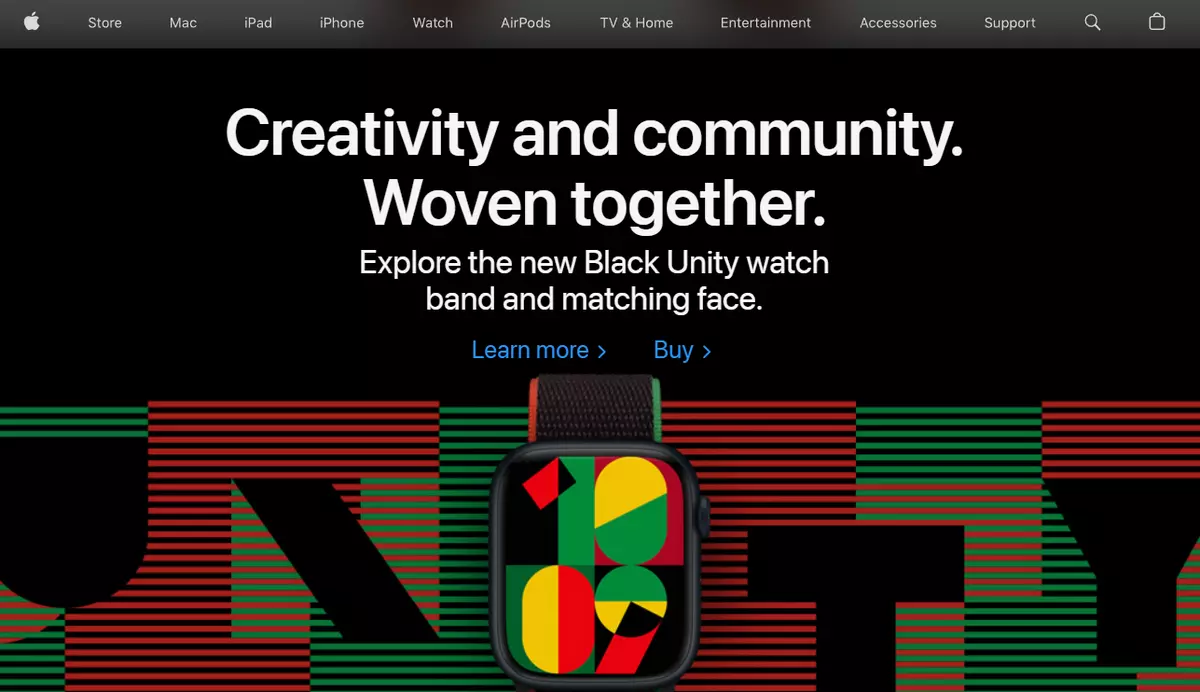
(Image taken from the official website)
3. McDonald's
"I'm loving it." I bet so do you. McDonald's has one of the most inspiring brand voice examples.
Taking a multi-dimensional and multi-segmented approach in 2002 and placing clients right at the center of everything, McDonald's has won our hearts by driving happy and customer-centric ideas. Today it is the most recognizable brand in the World thanks to its hyper-friendly atmosphere established with the help of brand voice and tone.
The latter impacts every aspect of customer communication. From employees' behavior, choice of words, and way of speaking to a copy in advertising pamphlets or websites, their friendly, amicable, and cheerful brand voice is everywhere.

4. Spotify
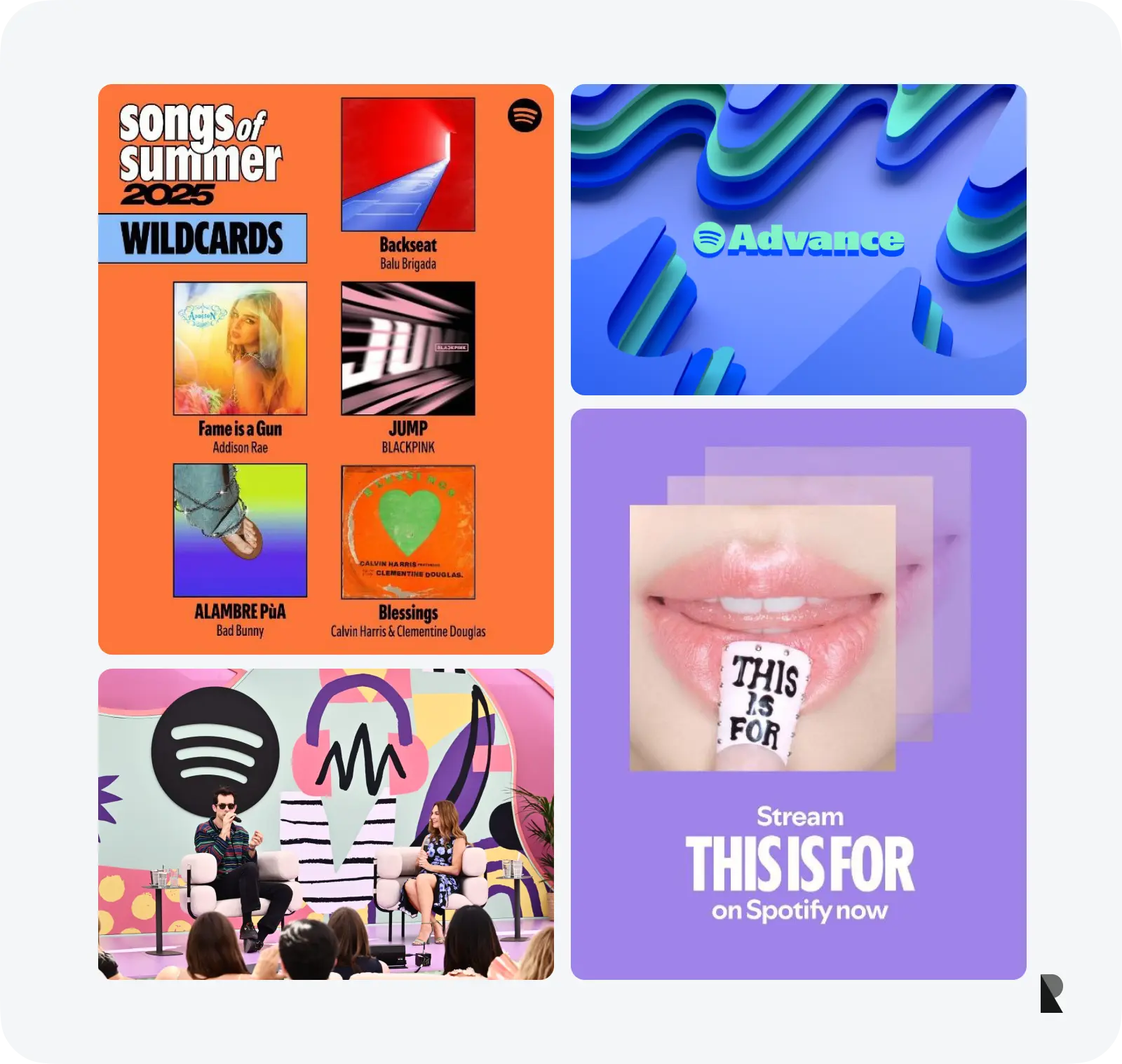
This fantastic music streaming brand takes it easy with brand voice. You will not see aggressive, masculine, and pushy messages like in the case of Harley Davidson. On the contrary, the brand stays neutral, inviting everyone into a relaxing and refreshing atmosphere.
Spotify is a great example that you do not have to be extreme with your brand voice – you just need to know how to "speak" with the audience on their terms.
The company sticks to a funny, edgy, direct, and concise brand voice, casually connecting with customers. It is also consistent all the time to strengthen existing relationships and easily break the ice with new clients.
5. Nike
"Just Do It" – should we say more?
We have included Nike in our collection because their well-done brand voice plays a crucial role in their resounding success.
Unlike McDonald's, which mainly targets families, their brand voice refers to all people in the World, with no exception. Using simple yet inspiring and to-the-point messages, it "speaks" to us, encouraging us to overcome obstacles. It makes us feel confident and assertive.
Nike is a case in point that brand voice matter, and it can do miracles with a company's position in the market.
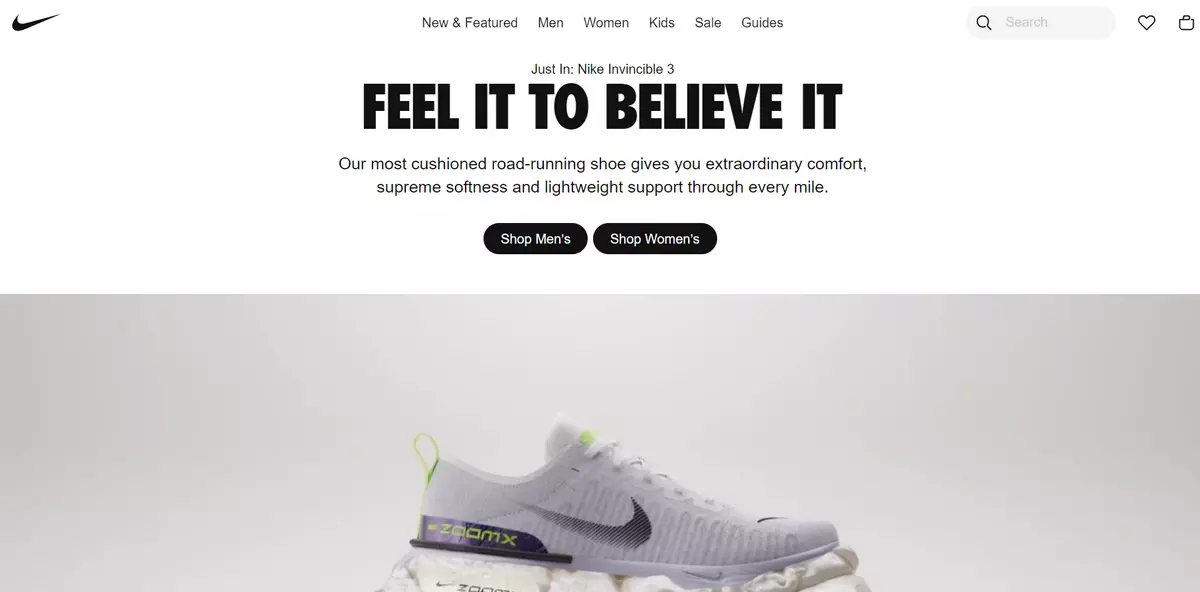
(Image taken from the official website)

Brand Stand: Importance of Maintaining Consistency
Do you know that according to recent studies, 90% of potential customers expect to have a similar brand experience with the brand across different social media platforms? Maintaining consistency is crucial for a company to secure its relationships with customers.
There is more. Due to oversaturated market, it takes time for customers to recognize and trust your content and ipso facto brand, which is why you must be patient and, most importantly, persistent.
So, what can you do to keep a consistent voice across different platforms?
- Unify and simplify rules.
- Avoid chaos or ambiguous elements in conceptualization.
- Align with your company's values and services or products.
- Make a well-organized and structured style guide. Ensure it is available 24/7, and everyone knows where to get it.
- Use clear, concise language and create a handy navigation system.
- Define your brand voice on paper. Print key points and hang them around the office.
Along with maintaining consistency, it is also crucial to regularly review current voice performance. Even though it is said that it should not change, there are some circumstances where it's good to alter your brand voice to make it resonate with the audience better. For instance:
- Your audience's preferences, expectations, and needs may change. Updating your brand voice to ensure the same level of communication is crucial.
- Your voice may become outdated over the course of time. While your brand's values should stay the same, when it comes to language, it should be updated to “speak” with the audience on the same terms.
- New opportunities and creative ways to communicate may arrive.
- Culture evolves as one generation replaces another generation. Vocabulary and the meaning behind certain words change. It is crucial to stay up-to-date.
- Brand identity and strategy may undergo significant changes.
Tweaking your messaging to engage more people is a regular thing, but you must do this tactfully. Schedule check-ups of the brand's voice performance to determine how well the current company's communications align with the target audience. If something needs to be fixed, introduce changes and enhancements to solve this issue.
Conclusion
Researches show that 40% of customers identify the company and separate it from the competition due to its memorable content and unique storytelling experience. Brand voice stands behind that. Though, it does much more than that. It underlies the communication between the company and clients, represents the brand's unique personality, and leaves a long-lasting impression that plays a crucial role in building a strong brand with wide recognition and a fine reputation.
Therefore, uncovering your distinctive brand voice, getting it right, and, most importantly, nourishing it along the way are essential for a company's survival.
Developing and maintaining a strong brand voice is challenging because it takes time for your audience to remember and recognize your brand. Plus, the market is evolving, and so do customers' preferences and expectations. Nevertheless, brand voice can still be found and established. For that, companies should undertake several crucial steps:
- Find a brand voice.
- Develop the brand voice specs.
- Ensure it is aligned with the brand's mission and vision and included in the brand strategy.
- Maintain consistency and coherence across all communication channels.
Remember, if a potential customer feels like you're talking directly to them, then your brand voice works. If not, it is time to revisit and alter it to make it resonate better with the audience.
Feb 24, 2023
